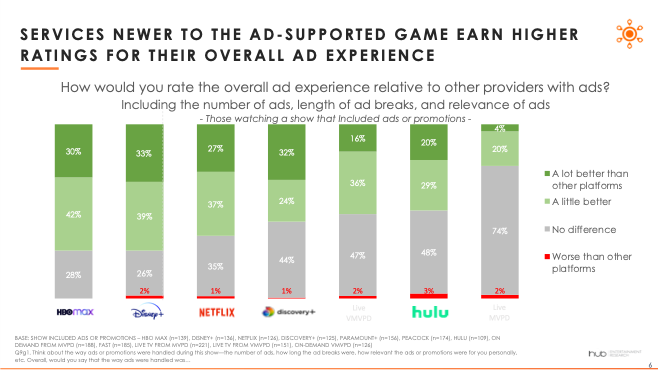
Advertising is not a viewer turnoff for streamers and the services that have most recently introduced ad-supported tiers get higher grades for their viewing experience, according to a new survey by Hub Research.
According to Hub’s Advertising: Fact vs. Fiction report, 33% of Disney Plus subscribers who have watched a show that included ads said the overall ad experience was “a lot better” than the experience on other ad-supported platforms
Similarly, 32% of HBO Max viewers thought their experience was better, as did 27% of Netflix subscribers. With Hulu, which has been ad-supported for years, 20% said the ad experience was superior. (The survey was conducted prior to HBO Max’s May 23 rebranding as Max.)
By contrast, only 4% of subscribers to traditional pay TV platforms thought the ad experience was superior and 16% of virtual multichannel video programming distributors (vMVPD) subscribers thought there experience was a lot better.
Hub also found that streaming viewers liked having a choice, with 38% saying the preferred a tiered service that let them choose whether or not they would see commercials, compared to 31% who like free, ad-supported services and 31% who like ad-free subscription services.

Services that offer such options can appeal to all consumer segments, Hub noted.
Even among those who told Hub they can’t tolerate ads, 31% said they’d rather save money if watching ads will cost $4 or $5 a month less than watching ad-free.
Ad-supported streaming services are also giving advertisers a better environment, so long as ad loads and the length of ad breaks are “reasonable.”
Hub found that 34% of viewers said the paid attention to ads and proms when shows had a reasonable spot load. When the ad load was considered “unreasonable,” those paying attention dropped to 23%. When the length of ad breaks were reasonable, 33% of viewers paid attention to ads and promotions, compared to just 25% when the ad break length was unreasonable.
“Consumers don’t just tolerate advertising in video content, in most cases they actually see benefits from it,” Mark Loughney, senior consultant to Hub, said. “It allows them to choose their preferred video tiers at lower cost, and when presented right, advertising results in a more engaging viewing experience.”
The Hub report is based on a survey of 3,063 U.S. consumers between the ages of 14 and 74 conducted in May.







